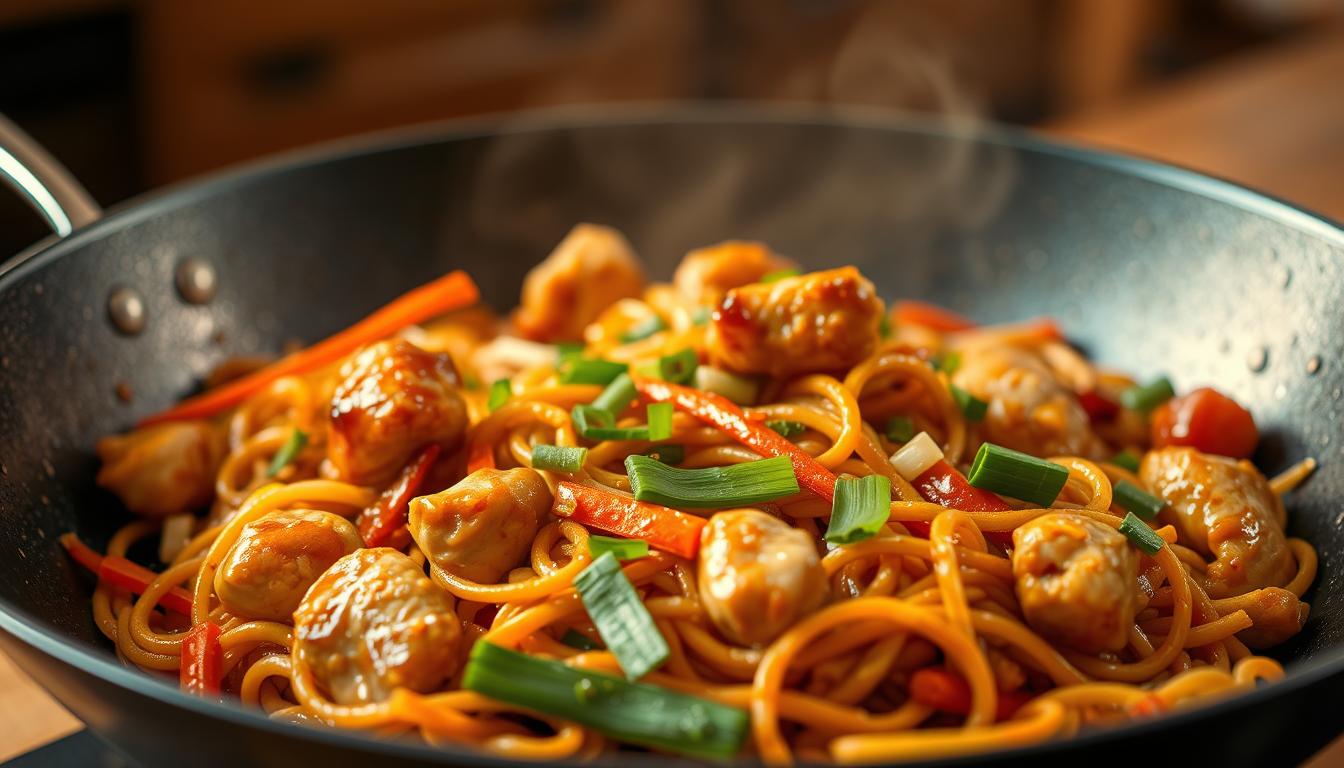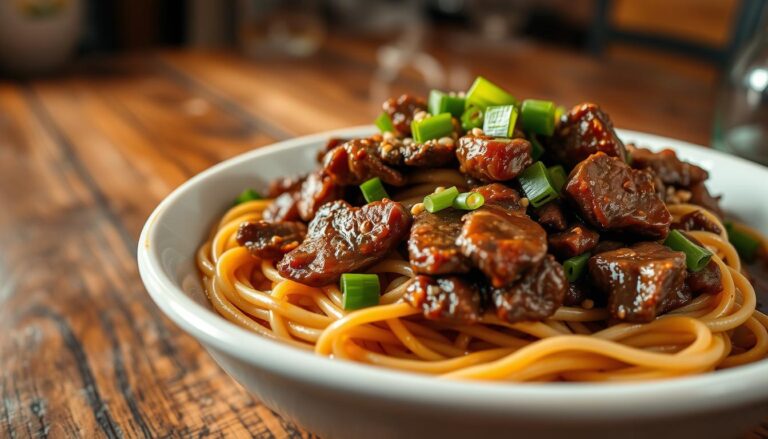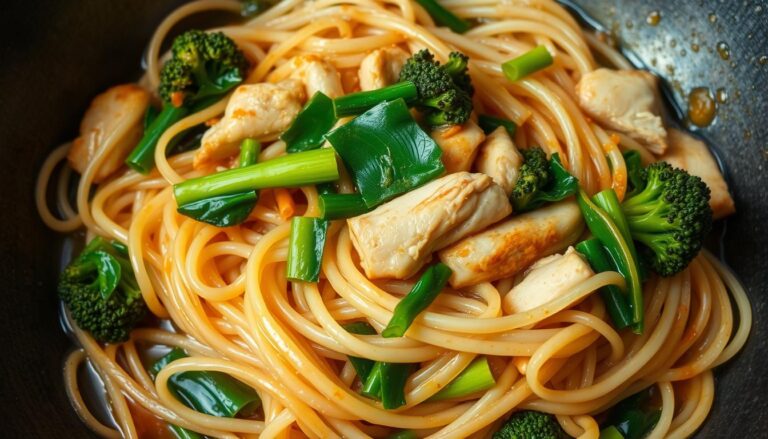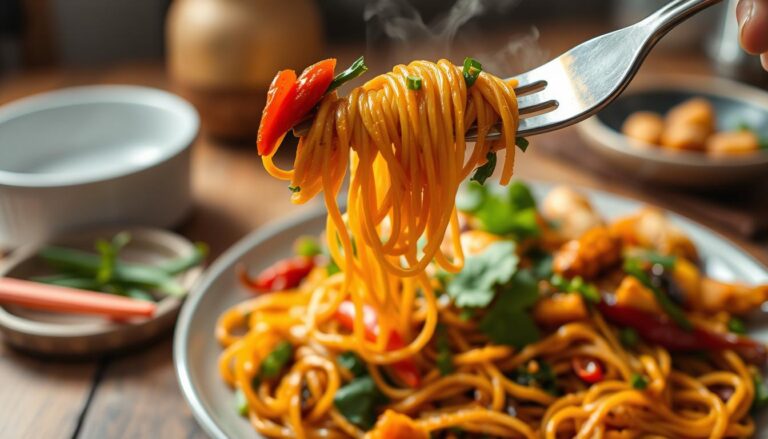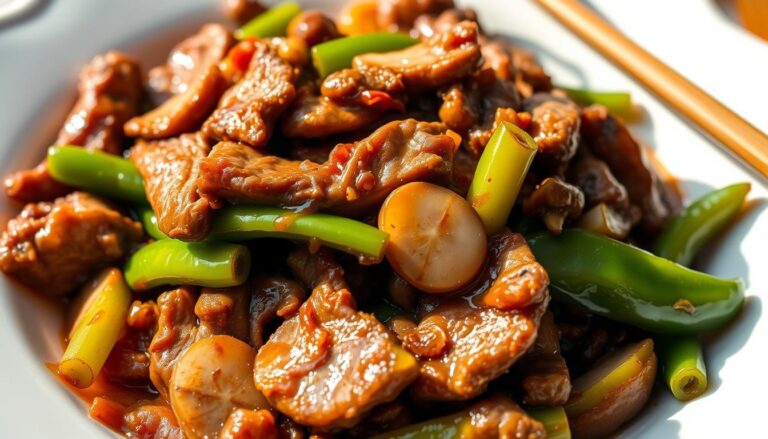Quick & Easy Garlic Chicken Lo Mein Recipe for Dinner
Craving takeout but short on time? This garlic chicken lo mein delivers restaurant-quality flavor in under 30 minutes. Perfect for busy weeknights, the recipe combines tender chicken, crisp veggies, and chewy noodles tossed in a savory Szechuan-inspired garlic butter sauce.
You’ll love how simple it is to customize with ingredients you likely already have. Follow our detailed package instructions to nail the noodle texture every time. We’ve balanced rich flavors using pantry staples like soy sauce, toasted sesame oil, and fresh ginger.
What makes this dish stand out? The bold garlic infusion and buttery finish elevate classic chicken mein into something extraordinary. No advanced skills needed – just a hot skillet and a hunger for delicious results!
Key Takeaways
- Ready in 30 minutes with minimal prep work
- Features a unique Szechuan garlic butter twist
- Includes foolproof package instructions for perfect noodles
- Easily adaptable with your favorite veggies or proteins
- Uses soy sauce and other sauces for layered flavor
Introduction to a Delicious Stir-Fry Experience
Say goodbye to bland meals with this vibrant stir-fry masterpiece. Unlike typical recipes requiring endless prep, our version delivers restaurant-worthy taste through smart shortcuts and bold flavor pairings.
Why This Recipe Shines Brighter
Time-crunched cooks love how the garlic-infused butter sauce transforms basic ingredients into something extraordinary. The magic happens when chewy noodles catch every drop of savory glaze, while crisp vegetables add refreshing crunch.
Most versions use pre-made sauces, but ours balances tangy soy with aromatic sesame oil. This creates layers of flavor that cling perfectly to tender chicken strips. You control the sodium and sweetness – something takeout can’t match.
Smart Cooking, Better Nutrition
Fresh bell peppers and snap peas pack vitamins without sacrificing texture. High-quality noodles cook faster than rice and provide satisfying chew. Swapping heavy oils for light sesame cuts calories while boosting nutty depth.
Got broccoli or shrimp? Throw them in! The recipe adapts to your fridge leftovers or dietary needs. One pan, 25 minutes, and you’ve got a meal that fuels your body without draining your time.
Ingredients and Equipment Essentials
Mastering this dish starts with quality components and smart tool choices. Fresh ingredients and simple equipment create restaurant-quality results without specialty store runs.
Fresh Ingredients and Flavorful Sauces
Build your flavor foundation with these essentials:
- 6-8 garlic cloves – freshly minced for bold aroma
- Mixed vegetables – bell peppers, carrots, and snap peas add crunch
- Avocado oil – high smoke point prevents butter from scorching
The sauce makes magic with soy sauce as its backbone. Combine it with toasted sesame oil and rice vinegar for tangy depth. Use low-sodium soy to control saltiness while keeping that umami punch.
Must-Have Kitchen Tools and Utensils
You need just three key items:
- Wok or cast-iron skillet – distributes heat evenly for perfect searing
- Sharp chef’s knife – makes quick work of chopping veggies
- Measuring spoons – ensure sauce balance isn’t guesswork
Prep all ingredients before heating your pan. This mise en place approach keeps cooking times under 10 minutes per batch. Fresh garlic turns bitter if overcooked, so add it last for maximum flavor impact.
Pair high-heat oils with butter during the final toss. This creates a glossy sauce that clings to every noodle. Your taste buds will thank you!
Prepping the Chicken and Vegetables
Transform basic ingredients into flavor-packed stars with smart prep work. Proper marination and knife skills ensure your dish cooks evenly and tastes restaurant-worthy.
Marinating the Chicken for Maximum Flavor
Start by cutting boneless chicken thighs into ½-inch strips. Uniform pieces cook evenly in the pan without drying out. For the marinade:
- 1 tbsp fish sauce for umami depth
- 1 tsp garlic powder for aromatic punch
- ½ tsp grated ginger for zesty warmth
Marinate 15 minutes – no longer, or the acid breaks down the meat. Web sources confirm this blend creates golden-brown edges when seared. The recipe shines when you pat chicken dry before cooking for better browning.
Chopping and Preparing Crisp Veggies
Shred carrots using a julienne peeler for quick, even strips. Slice bell peppers into matchsticks and green onions diagonally. Keep veggies cold until cooking to maintain crunch.
Pro tip: Cut everything same-width. This ensures your mein has balanced texture in every bite. Follow the recipe’s veggie ratios – too many watery vegetables dilute the sauce.
Noodle Selection and Package Instructions
Noodles make or break your stir-fry experience. The right choice ensures perfect chewiness while letting the sauce cling beautifully. Let’s explore how to pick and prepare them like a pro.
Choosing the Perfect Lo Mein Noodles
Traditional buckwheat noodles offer authentic texture – springy with slight nuttiness. For quicker options:
- Ramen noodles: Chewier alternative when boiled 1 minute less
- Udon: Thicker strands for heartier bites
- Rice sticks: Gluten-free option needing shorter cook time
Pair noodles with fresh ginger and cracked pepper to enhance their earthy notes. Check labels: some brands include cornstarch coatings requiring rinse steps.
Cooking Noodles According to Package Instructions
Undercook noodles by 60-90 seconds. They’ll finish cooking in the wok while soaking up sauce. Web sources confirm this prevents mushiness.
Key steps:
- Salt boiling water generously
- Stir immediately after adding to prevent clumps
- Drain thoroughly – excess water dilutes flavors
If using a standard pan instead of a wok, increase heat to high. Toss noodles quickly with ingredients to maintain texture. Always taste-test before removing from heat!
Creating the Perfect Sauce for Garlic Chicken Lo Mein
The soul of any great stir-fry lies in its sauce—your chance to layer flavors like a pro. This golden blend transforms simple ingredients into something unforgettable. Start with three core components: soy sauce for saltiness, hoisin for sweetness, and sesame oil for nutty depth.
Balancing Soy, Hoisin, and Sesame Oils
Combine 3 tbsp soy sauce, 2 tbsp hoisin, and 1 tsp fish sauce in a bowl. Whisk in 1 tbsp rice vinegar and ½ tsp sesame oil. Taste immediately—the mix should make your tongue tingle with salty-sweet tension.
Follow package instructions for pre-made sauces. Some hoisin brands need thinning with water. Others require less soy sauce. Adjust ratios gradually—add honey for sweetness or lime juice for brightness.
Customizing Your Sauce to Suit Your Taste
Love heat? Stir in chili crisp. Prefer tang? Boost rice vinegar. The time you add ingredients matters:
- Garlic goes in early to mellow its bite
- Sesame oil joins last to preserve aroma
- Cornstarch slurry thickens during final simmer
Always taste twice—once before cooking, again after heating. Flavors intensify when warmed. Need more umami? Dash in fish sauce teaspoon by teaspoon. Too salty? A pinch of brown sugar balances it out.
Remember: Even small tweaks create big changes. Your perfect sauce might be one adjustment away!
Garlic-Chicken-Lo-Mein: A Flavorful Stir-Fry Guide
Professional stir-frying turns ingredients into smoky, caramelized perfection. Unlike sautéing, this method relies on blistering heat and strategic timing to create those better takeout flavors you crave. Let’s break down the steps chefs use to achieve wok hei – the elusive “breath of the wok.”
Stir-Frying Techniques in a Wok or Fry Pan
Heat your pan until water droplets dance and evaporate instantly. Add chicken in a single layer – don’t overcrowd – and cook 90 seconds undisturbed. This creates golden-brown edges. Remove chicken immediately to prevent overcooking.
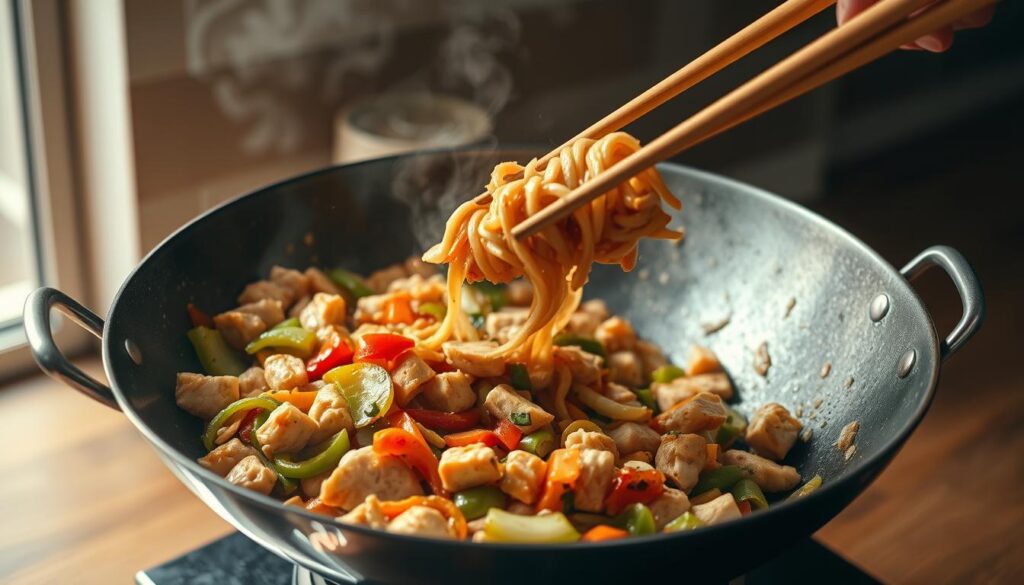
Next, toss veggies in batches. Start with carrots and bell peppers, then quick-cooking snap peas. Stir constantly for 60 seconds to lock in crunch. Web sources confirm this staggered approach prevents sogginess.
Achieving a Beautiful Sear and Even Cooking
Return chicken to the pan when noodles enter the mix. Use tongs to fold cooked noodles into the sauce – never stir aggressively. Follow package instructions for noodle doneness, as undercooked strands absorb flavors best.
Key searing tips:
- Pat chicken dry with paper towels before cooking
- Maintain oil temperature between 350-400°F
- Let ingredients char slightly on one side before flipping
When you add noodles according package directions, toss them with sauce first. This coating prevents clumping. Your final dish should sizzle as it hits the plate – a hallmark of better takeout quality achieved at home.
Tips & Tricks for Better Than Takeout Results
Elevate your home cooking with techniques that outshine your favorite takeout spot. Professional chefs swear by these simple adjustments to prevent soggy veggies and gluey noodles.
Preventing Overcrowding and Noodle Clumping
Cook in batches if using a standard skillet. Crowded pans steam ingredients instead of searing them. Set aside cooked chicken before adding vegetables to maintain high heat.
Undercook mein noodles by 90 seconds, then rinse under cold water. This stops the cooking process and removes excess starch. Toss with a teaspoon of sesame oil to prevent sticking.
Enhancing Flavors with Simple Adaptations
Boost depth by drizzling toasted sesame oil at the end. Its nutty aroma fades when overheated. For texture, toss in roasted cashews or crispy fried garlic during the final mix.
Follow noodles according to package directions, but reduce liquid slightly. Thicker sauces cling better to chewy strands. A splash of rice vinegar brightens rich flavors instantly.
Chefs recommend keeping components set aside until needed. This maintains ideal temperatures and prevents overcooking. Your dish will have the sizzle and crunch that makes restaurant versions irresistible!
Conclusion
Discover how simple techniques lead to an unforgettable meal. By prepping ingredients first and cooking in stages, you ensure every component shines. Following package instructions for noodles guarantees ideal texture, while quick sauce adjustments let you control flavor intensity.
This method proves that precision creates speed. Using cooked noodles according to their directions prevents mushiness. Balancing sauces early allows the garlic-chicken mixture to coat each strand perfectly. You’ll save time without sacrificing depth.
Feel free to swap proteins or vegetables – the framework stays foolproof. Whether it’s weeknight dinners or last-minute cravings, this lo mein adapts to your needs. Share your twists below, and let’s celebrate your kitchen wins!
FAQ
Can I use a different protein instead of chicken?
Yes! Shrimp, beef, or tofu work well. Adjust cooking times based on your protein choice—shrimp cooks faster, while beef may need extra searing.
How do I prevent noodles from sticking together?
Rinse cooked noodles under cold water after boiling and toss with a splash of sesame oil. This stops clumping and adds flavor.
What veggies can I substitute if I don’t have carrots or bell peppers?
Bok choy, snap peas, or broccoli are great swaps. Slice them thinly for quick, even cooking in the wok.
Can I make this dish gluten-free?
Absolutely. Use tamari instead of soy sauce and gluten-free lo mein noodles. Check labels on hoisin sauce or make your own.
How spicy is this recipe?
The base recipe is mild. Add red pepper flakes, sriracha, or chili oil to taste for heat. Start with ¼ teaspoon and adjust.
Do I need a wok to make garlic chicken lo mein?
A large skillet works too! Just ensure it’s hot and avoid overcrowding to achieve that classic stir-fry sear.
How long does marinating the chicken take?
15–20 minutes is enough for flavor absorption. For deeper taste, marinate up to 2 hours in the fridge.
Can I prep this meal ahead of time?
Store cooked noodles, veggies, and chicken separately in airtight containers for up to 2 days. Reheat in a pan with a splash of water.
Why does my stir-fry turn out soggy?
Overcooking veggies or adding too much sauce can cause sogginess. Cook on high heat and add sauce gradually toward the end.
Can I freeze leftovers?
Freezing isn’t recommended—noodles may become mushy. Store leftovers in the fridge and consume within 3 days for best texture.

